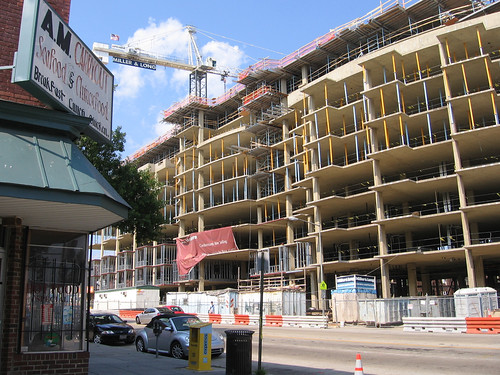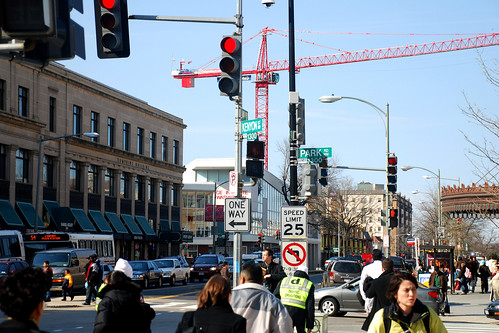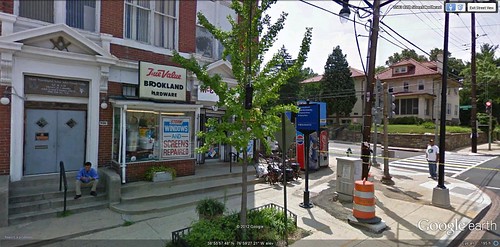Managing the increasing urbanization of Washington: sensitivity required

Posted May 29, 2012 at 1:28PM
Washington, DC, where I have lived for over 40 years, is changing. The central city of Washington is changing, and so is the metropolitan region. Both are becoming more urban. And, while I believe the changes are good for the city and good for the environment, they do not come without consequence or cost. How we manage the impacts of urbanization will determine residents’ quality of life for decades to come.
This has little to do with politics, by the way, unless we’re talking local politics. Outsiders and the media think of “Washington” as not a place but a soap opera of contested power in Congress and the presidency, as if real people don’t live here, sell real estate, work on cars and computers, make art and music, raise kids, and so on. (Random example: the long-running TV program This Week in Washington has nothing to do with the city of Washington or its residents.) I suppose we’re stuck with the caricature, as Detroit once was with the auto industry and Hollywood is with movies. If you’re a local, it’s annoying as hell; but that’s a rant for another day.
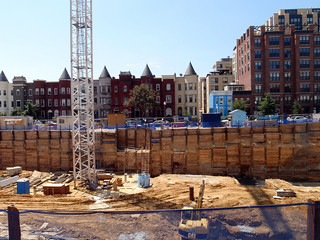 For today, let’s talk instead about growth, development, and the impacts. Last week, I was chatting with a friend who works in DC government, and she told me that the District of Columbia had added some 50,000 people since the central city began growing again (that’s big news in itself), but during the same period automobile registrations actually declined by 3,000. That is extraordinary, and ample testament to DC’s excellent transit access and increasing walkability.
For today, let’s talk instead about growth, development, and the impacts. Last week, I was chatting with a friend who works in DC government, and she told me that the District of Columbia had added some 50,000 people since the central city began growing again (that’s big news in itself), but during the same period automobile registrations actually declined by 3,000. That is extraordinary, and ample testament to DC’s excellent transit access and increasing walkability.
Do current trends support families?
But, as it turns out, the growth in the core has been a certain kind of growth. Jonathan O’Connell, in a lengthy and especially insightful article in The Washington Post, observes that the demographic most associated with the city’s remarkable turnaround comprises ambitious young professionals without kids. Indeed, a census analysis published last year showed that almost all of the city’s population increase over the past decade can be accounted for by an increase in residents between 20 and 35 years old. The number of children younger than 15 dropped by a fifth.
O’Connell wonders whether the city can hold onto its new residents as they mature:
“During the past decade, Washington has become a magnet for ambitious 20-somethings. Not only does the city offer good jobs and better-than-average public transit, it also boasts food trucks and, of course, cupcake shops . . .
“The influx of newcomers has transformed the city from a symbol of civic dysfunction and drab government offices to a cosmopolitan hub — an urban playground.
“The flood of newcomers did not arrive by accident. City planners and developers have bet big on luring transplants to the region. These are the people who will fill the more than 11,000 new apartments expected to be completed in the area in the next 12 months and whose income,
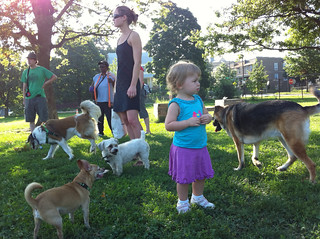
sales and real estate taxes are helping the city’s finances fare far better than those of similar urban areas. Long-blighted storefronts and commercial corridors are being rebuilt.
“What D.C. hasn’t yet figured out, or even really planned for, is what happens when this raft of newcomers grows out of one-bedroom condo living. What happens when their lives evolve past the urban-playground stage and they are less interested in speakeasies than in parks for their kids?”
Excellent question. And there are also the matters of public education and safety. My sense is that the city’s schools are, in fact, getting better, but slowly, and maybe not fast enough for residents currently starting families and having choices about where to live. As for crime, DC is much, much safer than it was, say, 20 years ago; but the parts of the city that are most rapidly urbanizing include some neighborhoods that are still sketchy for kids.
O’Connell offers three pragmatic recommendations that he believes can help the city do a better job of accommodating young families:
- “Develop places — public and private — where children can eat and play, something many District neighborhoods lack . . . Family-friendly restaurants are critical, but right now D.C. is building bars more quickly.
- “Diversify the housing stock. Incentives for developers to build larger units would provide more housing options for families.”
- Build parks along with new residential development.
Those seem almost ridiculously sensible to me, if also a bit modest. Implementing them would be a start, at least.
Winners and losers in urbanization
A related problem, and this may apply more to urbanizing suburbs than to the central city, is that some neighborhoods that have traditionally been quiet and family-friendly are becoming much busier. I recently received an email from someone I don’t know, who lives in a northern Virginia suburb of DC. The area where she lives is ripe for redevelopment, and there are major commercial and residential projects in the works. She sees her single-family home as threatened by the prospect of high-rises and much more traffic.
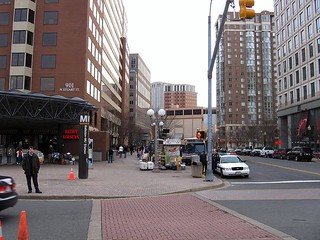 To be honest, I’m not sure I blame her. While I believe the area in question should be urbanized, the fact is that there are winners and losers when a place evolves. If your preference is for peace and quiet, and you don’t mind driving to get most anything done (which is very normal for most Americans), the increased walkability and amenities that come with intense new development may not be enough to make the evolution suit your needs.
To be honest, I’m not sure I blame her. While I believe the area in question should be urbanized, the fact is that there are winners and losers when a place evolves. If your preference is for peace and quiet, and you don’t mind driving to get most anything done (which is very normal for most Americans), the increased walkability and amenities that come with intense new development may not be enough to make the evolution suit your needs.
The seldom-acknowledged paradox of smart growth is that it manages impacts by concentrating them. When dense development comes to an established community, the metropolitan region may well benefit from reduced driving, land consumption and emissions compared to what would happen if the development instead took the form of additional suburban sprawl. But a particular location that is becoming more intensely urban may not enjoy those benefits. In the case of my correspondent, it doesn’t help that her neighborhood is not especially well-served by transit. (Put another way, it’s not Arlington, where a ton of intense new development has been absorbed with minimal impact on nearby single-family neighborhoods, largely because of the presence of excellent fixed-rail transit.)
The only answer I have for her is that the region needs for the development near her home to happen, and it’s not realistic to expect places to stay the same over time. If you’re comfortable with that answer, I’ll give you her address. I’m not.
The effect of changing demographics
As difficult as that problem is, far more difficult in my opinion may be a perceived loss of community identity and influence among African-Americans in city neighborhoods that are becoming whiter. My DC government friend also told me that, although the central city has been “majority minority” since 1970 (actually since 1960), that is soon going to change. People of all races are moving into DC, and people of all races are moving out for various reasons. But the net impact is that the city is becoming whiter, and the disparity in wealth between white and black residents is getting worse, not better.
That, by the way, is in part because black families want good schools and neighborhood parks, too. Many affluent and middle-class African-Americans have moved to the suburbs in recent years.
Part of the issue, of course, is gentrification: as DC becomes more desirable as a place to live, home sellers and landlords can command higher prices, especially for properties in the most walkable neighborhoods. (Home sale prices in the central city have either gone up, or suffered far less from the recession and its aftereffects than prices in the suburbs.) Net affordability goes down. Policies can and do mitigate the effect somewhat, but not enough to allay legitimate concerns about displacement. Unless you are a homeowner, in which case the changes will benefit you as your asset appreciates in value, you may be priced out of changing neighborhoods if your income is low.
But I think it’s a mistake to view the issue as only about affordability. When whites fled the central city in droves as suburbanization took hold, and especially after massive rioting in 1968 following the assassination of Dr. Martin Luther King, a lot of things changed. The flight of investment was especially tragic, as it was in other cities: the city’s declining tax base had a serious effect on the quality of municipal services, infrastructure and, not incidentally, public schools.
But a side effect was that those who remained, mostly African American, gained influence, over both the city at large and their own neighborhoods. “Chocolate City” became an expression of ethnic pride. In 1950, the city was 65 percent white; by 1970, it was 71 percent black, an astounding change. But, in 2010, African Americans composed only 50.7 percent of the city’s population, the rest mostly white (38.5 percent) or Hispanic (9.1 percent). (The racial composition of the metropolitan area as a whole in 2010 was 55 percent white, 26 percent black, 14 percent Hispanic, 9 percent Asian, and 4 percent “mixed and other.”)
A recent story by Nikita Stewart and Mike DeBonis in The Washington Post reported that, for the first time since DC has been allowed to elect a mayor beginning in 1973 (outrageously, we still have no voting representation in the US Congress), there is a real chance that the next holder of the office could be something other than African-American. There are two serious white candidates considering a run in 2014.
Many longstanding residents of inner-city neighborhoods that are seeing revitalization and an influx of new, often more affluent, younger, and whiter, residents are distrustful of changes that are accompanying the newcomers – a dog park here, a bike lane there, maybe a new restaurant. While they may not express it this way, I think a big part of their concern stems not just from worries about traffic or whatever but also from the perception that the changes are not coming from within their community. They feel they are losing control over their neighborhoods.
I find that completely understandable. Will time overcome the fears? Maybe, and I hope so. I asked another friend in DC government about this, and whether the city might benefit from an “ambassador” to affected neighborhoods who understands both sides and can help build trust. That might have been a naive idea to throw out there, but I do think that being sympathetic to longstanding residents’ concerns is important, even (maybe especially) if revitalization continues to occur, as I believe it will and should.
I’m not sure my friend fully understood the question, and his reaction was a bit defensive. I hope it was just a miscommunication – we were having a chance encounter – because I think there may be no more important issue facing the city today. As I wrote in a previous article, it was a huge (if somewhat sublimated) factor in the last mayoral election, and I don’t see it going away anytime soon.
Managing the impacts of change
To bring this set of reflections back to where I started, I believe the increasing urbanization of Washington (and, for that matter, other cities and metro areas) is necessary and good – for the environment, for the economy, for our social fabric. The alternative of the kind of chaotic suburban sprawl we suffered during much of the last 50 years is completely unacceptable. I’ve staked my career on those propositions.
But we shouldn’t pretend that it’s going to be universally good for all stakeholders, or that the costs that accompany the benefits don’t matter. We should be clear-eyed about them, and do everything we can to mitigate them, heal any wounds suffered along the way, and accommodate changing needs. If that means compromise or accepting a somewhat lesser degree of urbanization in some cases, I’m fine with that.
Related posts:
- Is 'gentrification' always bad for revitalizing neighborhoods? (October 19, 2011)
- The greening of DC's LeDroit Park neighborhood (featuring a Baptist church, a farm, & HRH The Prince of Wales) (May 5, 2011)
- How much urbanism is enough? (January 13, 2011)
- A portrait of a neighborhood in transition (September 2, 2010)
- Reflecting national central-city trends, DC population rises while crime plummets (January 5, 2010)
- Dogs breed neighborhood civility, so why can’t we all just get along? (July 23, 2009)
- Unofficial Washington: how architecture shapes the real city (November 24, 2008)
Move your cursor over the images for credit information.
